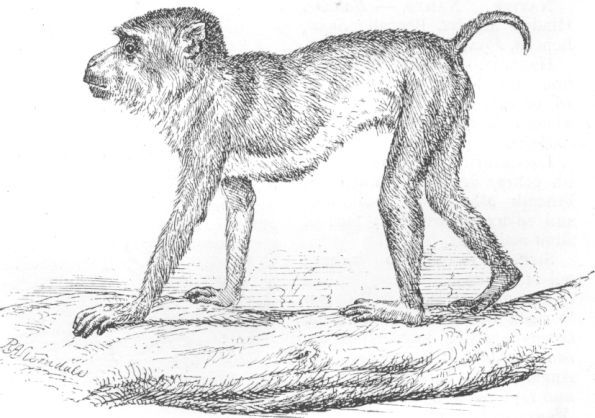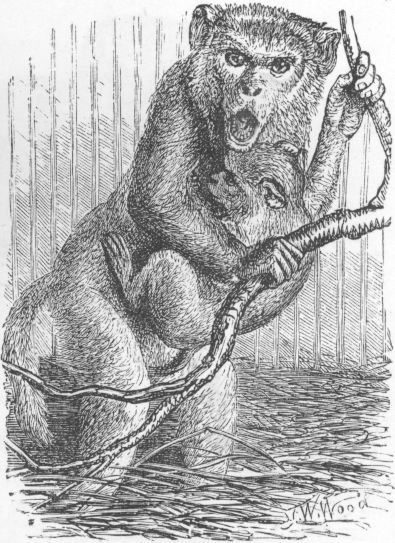| Page 9 | |
|
Natural History of the Mammalia of India and Ceylon - by Robert A. Sterndale F.R.G.S., F.Z.S. (1884) | |
| prev page next page | contents |
|
18. INUUS vel MACACUS RHESUS. The Bengal Monkey (Jerdon's No. 7).
NATIVE NAMES.—Bandar, Hindi; Markot, Bengali; Suhu, Lepcha, Piyu, Bhotia.
HABITAT.—India generally from the North to about Lat. 18° or 19°; but not in the South, where it is replaced by Macacus radiatus.
DESCRIPTION.—Above brownish ochrey or rufous; limbs and beneath ashy-brown; callosities and adjacent parts red; face of adult males red.
SIZE.—Twenty-two inches; tail 11 inches.
This monkey is too well-known to need description. It is the common acting monkey of the bandar-wallas, the delight of all Anglo-Indian children, who go into raptures over the romance of Munsur-ram and Chameli, their quarrels, parting, and reconciliation, so admirably acted by these miniature comedians.
NOTE.—For Macacus rheso-similis, Sclater, see P.Z.S. 1872, p. 495, pl. xxv., also P.Z.S. 1875, p. 418.
19. INUUS vel MACACUS PELOPS. Syn.—MACACUS ASSAMENSIS. The Hill Monkey (Jerdon's No. 8).
HABITAT.—The Himalayan ranges and Assam.
DESCRIPTION.—Brownish grey, somewhat mixed with slaty, and rusty brownish on the shoulders in some; beneath light ashy brown; fur fuller and more wavy than in rhesus; canine teeth long; of stout habit; callosities and face less red than in the last species (Jerdon). Face flesh-coloured, but interspersed with a few black hairs (McClelland).
20. INUUS vel MACACUS NEMESTRINUS. The Pig-tailed Monkey.
HABITAT.—Tenasserim and the Malay Archipelago.

Macacus nemestrinus
DESCRIPTION.—General colour grizzled brown; the piles annulated with dusky and fulvous; crown darker, and the middle of the back also darker; the hair lengthened on the fore-quarters; the back stripe extends along the tail, becoming almost black; the tail terminates in a bright ferruginous tuft. This monkey is noted for its docility, and in Bencoolen is trained to be useful as well as amusing. According to Sir Stamford Raffles it is taught to climb the cocoa palms for the fruit for its master, and to select only those that are ripe.

